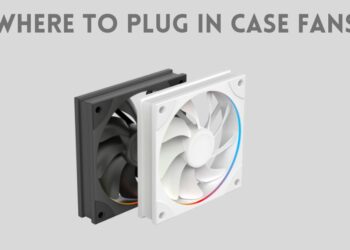Properly sized and installed case fans play a critical role in effective cooling and thermal performance of your computer.
But before purchasing new fans or replacements, you need to intimately understand the right specifications and measurements.
This comprehensive guide will teach you everything you need to know about accurately and precisely how to measure case fans.
We’ll start with a quick answer on the key methods for determining fan dimensions. Then we’ll dive deeper into specifics on measuring various fan properties, choosing the optimal fans for your setup, proper installation best practices and more.
Let’s get started!
Quick Answer: How to Measure Case Fans
There are three primary ways to measure the exact size of a case fan:
- Measure the fan itself from edge to edge horizontally using a tape measure. Record the measurement in mm.
- Measure mounting holes from center to center horizontally. Add 10-15mm for approximate fan size.
- Check manufacturer specs listed on the case or fan packaging that denote the fan dimensions.
What are Case Fans?

Case fans are small cooling fans, typically 80mm to 140mm in size, installed inside computer cases used to actively circulate internal air and dissipate heat generated from components. Standard case fans utilize axial fan blades that blow air directionally through the case, either as intakes on the front/bottom, or exhaust outlets on the rear/top.
Proper case fan size and strategic placement is absolutely critical for allowing cool external intake airflow through the front and bottom vents, while hot interior exhaust air can escape from the upper rear and top vent locations. Undersized or misaligned fans can lead to poor convection and excessive component heating, which can cause unexpected crashes, throttling and reduced lifespan.
By understanding how to accurately measure and strategically install computer cooling fans, you can optimize thermal performance, system stability and longevity of your precious PC hardware. Keep your processors, GPUs, RAM and drives running reliably for years to come!
Methods for Precisely Measuring Fan Size
There are three simple and effective methods to determine the exact physical size of an already installed case fan, or the required dimensional constraints for a new replacement fan to fit a specific PC case mount location.
Measuring the Fan Itself Directly
This is the most straightforward approach when you have physical access to the fan itself outside of the restrictive computer case interior.

- Use a flexible tape measure and carefully position it aligned horizontally across the fan housing frame, lining up the edges precisely with the sides of the fan casing from edge to edge.
- Avoid diagonal measurements from corner to corner.
- Read the millimeter measurement value and record this number digitally or on paper – common standard sizes are 80mm, 92mm, 120mm, 140mm, 200mm and up.
- Larger fans will have proportionally stronger airflow.
- Alternatively, for perfectly centered mounting, measure accurately in millimeters between the horizontal screw holes themselves rather than the external housing edges.
For example, a common 120mm fan will measure 120mm across the entire outside edge dimensions. Meanwhile, the horizontal mounting holes will measure 105mm apart.
Measuring Mounting Holes
If unable to easily access the physical fan itself, you can derive its closest approximate size by measuring the empty fan bracket screw holes instead:

- Locate and visually identify the open mounting points designed for fan attachment on the inside of the case frame.
- There may be multiple mounting locations like front, back, top, etc.
- Carefully use your tape measure aligned perfectly horizontally between the center of one screw hole to the center of the opposite facing hole.
- Avoid any angular skew when measuring.
- The measured mounting hole distance will be 10-15mm less than the actual corresponding fan’s total edge-to-edge size.
- Since holes are inset from the frame corners.
- For example – 105mm holes indicate room for a 120mm fan, while 82.5mm holes match to a 92mm fan.
This table matches up the standard horizontal hole spacing distances to their associated case fan sizes:
| Fan Size | Screw Hole Spacing |
|---|---|
| 40 mm | 32 mm |
| 50 mm | 40 mm |
| 60 mm | 50 mm |
| 80 mm | 71.5 mm |
| 92 mm | 82.5 mm |
| 120 mm | 105 mm |
| 140 mm | 124.5 mm |
| 200 mm | 154 mm |
So if measuring horizontal hole spacing inside your PC yields 82.5mm, you would shop for a 92mm case fan to correctly fit.
Checking Manufacturer Fan Specs
Finally, you can definitively determine required fan size fitment from the technical size specifications provided right on the PC case itself:
- The case’s original packaging, included instruction manual or separate specification documentation will clearly list officially supported fan sizes.
- Sometimes denoted alongside specific mounting locations.
- For example, a modern 2022 PC mid-tower case may list compatibility for:
- (2) 120mm dedicated intake fans in the front panel
- Plus 140mm exhaust fan clearance on the rear mount bracket.
- When selecting replacement fans, be 100% sure to cross-reference your physical measurements with the listed case manufacturer hardware specs for guaranteed dimensional and electrical compatibility.
- Avoid guessing approximate sizes.
So in summary, take physical fan or case measurements first, then directly verify those dimensions against manufacturer guidance second.
5 Key Considerations When Choosing Case Fans
While accurate horizontal fan fitment size is absolutely critical for case compatibility, there are several other very important technical factors to consider as well when shopping for case fans:
1. Airflow Volume (CFM)

The maximum airflow volume rating indicates the total cooling effectiveness and convection potential of any given fan:
- Airflow or CFM (cubic feet per minute) denotes total volume of air moved.
- Higher CFM values allow more heat to be transferred away from hot components.
- In general, the best fan choices for unrestricted areas like rear exhaust mounts will be oriented towards maximum airflow over other attributes.
2. Static Air Pressure
The static pressure rating measures the fan’s ability to overcome airflow resistance from filters, grills or tight spaces:
- Static Pressure specified in mm-H20 (millimeters of water) indicates the amount of resistance a fan can push/pull air against.
- Higher pressure fans perform better when forcing airflow through tight spaces or mesh filters – at the cost of increased noise.
- Fans with excellent static pressure specifications excel as intake fans on front panels or radiator cooling.
Therefore, high raw airflow fans work best for unrestricted rear or top exhaust vents, while higher static pressure models allow for air intake directly through thick front panels or meshes without stall. Balanced fans offer flexibility for either application.
3. Operating Noise Level

Fan noise is measured objectively in decibels relative to human hearing perception (dBA):
- Lower dBA ratings equate to less audible humming or buzzing noises emitted.
- What is considered “quiet” is highly subjective based on your priorities:
- <30 dBA – Virtually inaudible, optimal for noiseless builds.
- 30-40 dBA – Balanced between cooling performance and noise.
- >40 dBA – Obtrusive hum but maximizes cooling capacity.
- If your PC is located in a home theater or bedroom, quieter fans are strongly advised.
4. RPM Speed Range

Faster spinning computer fans achieve better cooling performance, but consequently also use more electricity and wear down over time at accelerated rates:
- Fan RPM speed indicates rotations per minute from around 800 RPM on the low end, up to 2,500+ RPM for high velocity turbine models.
- RPM directly correlates with noise level.
- Consider lowering fan speeds if your PC will run 24/7 to increase longevity.
- Many fans support variable speeds.
- Just ensure active cooling is still adequate for your particular hardware.
5. Power Consumption
Fan motors draw additional electrical load in terms of wattage, so factor this into your overall PC power budget:
- More powerful or higher RPM fans require increased power supply overhead.
- Use online PSU wattage calculators to ensure your total DC power budget has margin.
- Electro-mechanical fans will wear down over years of continuous use. Plan for replacements.
While proper physical sizing is the first order criteria, factor these performance attributes into your case fan selection process as well.
6 Common Case Fan Sizes

While aftermarket fan models can vary wildly in terms of airflow, noise and lighting features, their physical construction and dimensions hew more closely to industry standards. Here are the 6 most prevalent standard case fan sizes seen in modern mid-tower PC builds:
- 80mm – 3.1 inches square. Compact, lower airflow. Used heavily in small form factor (SFF) PC builds.
- 92mm – 3.6 inch square. Marginal cooling improvement over 80mm.
- 120mm – 4.7 inches square. Most popular size, widely available. Excellent balance of airflow to noise.
- 140mm– 5.5 inch square. Great balance of quiet acoustics and airflow volumes.
- 180mm – 7 inch square. Uncommon, seen in some unique cases.
- 200mm – 7.9 inch square. Massive fans for maximum airflow. Require larger cases.
As mentioned previously, the physical external edges of a fan will always measure slightly larger than the horizontal center-to-center distance between their four internal mounting screw holes. This allows some minor wiggle room when aligning fans to their case mounting brackets.
Why 120mm and 140mm Fans Dominate?
The 120mm fan standard in particular strikes the best balance between high airflow convection and low operating noise, while avoiding the power draw and high RPM velocities of larger 180mm+ fan designs. These qualities, along with excellent physical compatibility across virtually all modern PC cases is why 120mm and 140mm models dominate the enthusiast market.
Consider stepping up to 140mm models for intake fans whenever possible, as the added blade surface area allows for higher volume air movement at lower RPM speeds – resulting in powerful but near-silent operation. They do cost slightly more than smaller 80mm or 120mm equivalents however.
Learn more about 120mm vs 140mm case fans here.
Proper Strategic Fan Placement and Installation
Once you’ve verified the specifically required fan dimensions to match your PC case mounting locations, here are some best practice guidelines to follow when actually installing the fans into the chassis:
- Intake fan positioning – Front and bottom mounts should utilize directional intake fans – optimized for static pressure and filtration.
- Exhaust fan mounting – Rear and top fans should focus on noise-normalized high airflow extraction.
- Use fan gaskets, rubber dampeners or vibration minimizing mounting screws to reduce noise.
- Ensure your PSU wattage can support additional fan power draws added to your build.
- Carefully check for any potential stability issues or component clearance conflicts before securing fans. They should never directly contact other hardware while spinning.
- Adjust variable voltage controls to reduce fan speeds as permissible per measured CPU/GPU thermals.
Taking care when measuring for and finally installing high CFM case fans with optimal directional airflow convection will keep your system temperatures low and overall stability high. Now enjoy your upgraded computing experience!
Conclusion
There are primarily three simple but effective techniques for accurately measuring cooling fans – use a millimeter tape measure across the external housing, internal screw holes, or reference technical specification sheets from the manufacturer.
Combine your physical measurements with computer case vendor guidance on supported fan dimensions for each mount point in the enclosure. This allows you to determine the precise fans required with 100% known compatibility.
Beyond physical size, pay close attention to volumetric airflow (CFM), noise profiles (dBA), speed (RPM) and static pressure ratings when selecting optimal intake/exhaust fans. And be sure to install them in precise alignments to achieve front-to-rear or bottom-to-top airflow conveyance according to individual PC cooling requirements.
Following this comprehensive guide on precisely how to measure case fans will directly result in superior cooling while preventing any issues from incorrect sizes or fan positioning. Keeping your delicate electronics at ideal operating temperatures improves stability, reduces risk of failure and extends productive lifespan. Measure twice, cut once!
FAQ’s
What is a normal fan size?
A normal fan size is 120mm or 140mm. These mid-sized fans offer a good balance of airflow and low noise.
What is 1200 mm in fan?
There is no standard 1200mm fan size. Typical fan sizes range from 80mm to 230mm.
What is a good fan size?
Good fan sizes are 120mm and 140mm. They move sufficient air with modest noise levels and fit most PC cases.
What is fan capacity?
Fan capacity refers to the airflow potential measured in CFM. Higher CFM fans move more air per minute.
How to choose a fan?
Choose fans based on size compatibility, airflow needs, noise tolerance, RGB lighting preference, and fan control method.
Are bigger fans better?
Not necessarily. Larger fans like 200mm models move more air at lower speeds. But 120mm or 140mm fans are more common and provide ample cooling already.
What is the best amount of case fans?
3-4 total case fans is ideal. Use 2-3 as cool air intakes and 1-2 as hot exhaust fans. More fans can improve temperatures but add expense and noise.
How do I know which case fan to buy?
Match the fan size to your case mounts. Pick airflow or static pressure fans based on placement and obstacles like radiators or filters in the path.
What is CFM for case fans?
CFM measures airflow capacity. 50-70 CFM is good for most applications. High airflow fans exceed 100 CFM.
How do you calculate CFM?
CFM is specified by the fan manufacturer. It represents cubic feet per minute of air moved at maximum speed. You cannot manually calculate CFM.













